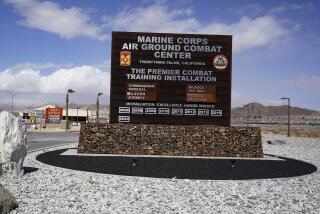Keep Risks on Battlefield
- Share via
Soldiers understand the risk of dying from sniper fire in Afghanistan or a grenade attack in Iraq, but too often it’s the off-base car crash or avoidable training accident that kills them. Times writers Alan C. Miller and Kevin Sack reported Sunday that 575 servicemen and women died in accidents during the fiscal year that ended Sept. 30. It was the second consecutive year that noncombat fatalities rose, and it represented a 64% increase from 1998. The death rate for active-duty personnel in accidents last year was the highest in eight years. These alarming figures demand both attention and follow-through from the Pentagon.
Despite periodic nods at improving safety, military officials sometimes take too long to react to noncombat problems.
Fighter pilots often have good reason to fly on the edge of safety in training and combat, but aircraft ferrying troops from base to base should be as safe as civilian planes. Yet the General Accounting Office, the investigative arm of Congress, reported last year that “the military services have lagged as much as two decades” behind civilian regulators in requiring cockpit technology that warns of a possible collision.
After an Air Force C-141 collided with a German military plane off the coast of Africa in September 1997, killing all nine crew members on the U.S. plane and 24 on the German aircraft, it took five more years to equip all C-141s with collision warning devices.
Defense Secretary Donald H. Rumsfeld understands the problem. In May he told the services to cut the number and rate of accidents by half within two years, a good goal. In the 1990s, safety oversight positions in the Secretary of Defense’s office were reduced from five to one. Rumsfeld should reinstate those high-level positions to have more oversight of the hundreds of staffers who try to ensure that weapons don’t misfire and new combat vehicles don’t crash.
The Pentagon appointed a group of senior officials to determine why accidents were increasing and to make plans to reduce them. That should produce needed improvements, but good intentions can get buried in bureaucracies, particularly when overshadowed by priorities like fighting wars.
Young men who think they are invincible and are trained to face danger are susceptible to roaring off base and taking curves at high speeds. The Defense Department has a traffic safety program but it’s not enough. Part of the services’ mission is to minimize preventable deaths. That means ensuring that off-duty troops who have been drinking use taxis or other rides the services provide, that repeat traffic violators are counseled and overly fatigued soldiers and sailors are ordered to recuperate before getting behind the wheel. Funds for teaching such lessons should be part of every unit’s budget.
More to Read
Sign up for Essential California
The most important California stories and recommendations in your inbox every morning.
You may occasionally receive promotional content from the Los Angeles Times.













